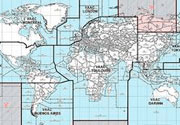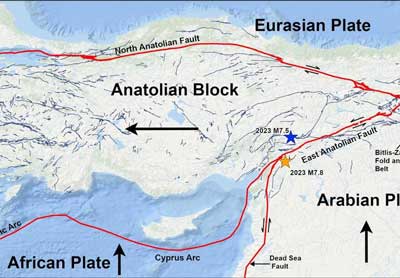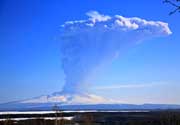On 25 September PHIVOLCS warned of potential lahars around Pinatubo due to intense rains from a typhoon expected during 25-26 September. Significant deposits from 1991 pyroclastic density currents on the W flank may be remobilized, generating lahars down major drainages in that watershed. PHIVOLCS noted that the communities of San Marcelino, San Narciso, San Felipe, and Botolan, Zambales Province, and communities in Tarlac and Pampanga Provinces may be affected by lahars and flooding.
On 25 September PHIVOLCS warned of potential lahars around Pinatubo due to intense rains from a typhoon expected during 25-26 September. Significant deposits from 1991 pyroclastic density currents on the W flank may be remobilized, generating lahars down major drainages in that watershed. PHIVOLCS noted that the communities of San Marcelino, San Narciso, San Felipe, and Botolan, Zambales Province, and communities in Tarlac and Pampanga Provinces may be affected by lahars and flooding.
Wed, 1 Dec 2021, 08:06
PHIVOLCS reported that a weak phreatic explosion at Pinatubo was recorded during 1209-1213 on 30 November. The event was likely drive by shallow hydrothermal processes based on very low seismicity recorded during the previous few days, low diffuse carbon dioxide flux from the lake, and a notable infrasound signal. A plume mostly comprised of steam was seen rising above weather clouds within a few minutes of the end of the event.
Read allTue, 30 Nov 2021, 10:40

Ash cloud forecast from the possible eruption of Pinatubo today (image: Tokyo VAAC)
: PHIVOLCS confirmed a phreatic explosion took place at the volcano today from 12.09-12.13 p.m. local time. The explosion did not involve new magma, but was a result of overheated fluids of the shallow hydrothermal system. It generated a tall plume consisting mostly of steam and only little ash:
Read allWed, 24 Nov 2021, 06:00
PHIVOLCS reported that a weak phreatic explosion at Pinatubo was recorded during 1209-1213 on 30 November. The event was likely drive by shallow hydrothermal processes based on very low seismicity recorded during the previous few days, low diffuse carbon dioxide flux from the lake, and a notable infrasound signal. A plume mostly comprised of steam was seen rising above weather clouds within a few minutes of the end of the event.
Read allMon, 15 Mar 2021, 04:12
Over the past week, 8 March to 15 March 2021, the Philippine Institute of Volcanology and Seismology (PHIVOLCS) recorded a total of 91 volcanic earthquakes. No other activities were observed over the course of the week. PHIVOLCS maintained the alert level 1 (weak unrest) over Pinatubo.
Mon, 8 Mar 2021, 08:33
Since its alert level increase from 0 to 1 last 4 March 2021, Pinatubo Volcano had only experienced about 1 to 9 daily volcanic quakes. According to the latest volcano bulletin issued by PHIVOLCS today, 8 March 2021, there has been an increase in number of volcanic quakes recorded. In the last 24 hours, a total of 35 quakes were recorded. However, these quakes may be related to “tectonic processes beneath its edifice, and that no imminent eruption is foreseen”.
Read allThu, 4 Mar 2021, 01:10
The alert level for Mt. Pinatubo was raised today, 04 March 2021, from level 0 (quiet) to level 1 (low unrest). Since 20 Jan. 2021, a total of 1722 imperceptible quakes have been recorded by PHIVOLCS'Pinatubo Volcano Network (PVN). Latest measurements of CO2 and temperature on Feb. 2021, yielded slight increase. The CO2 flux measured was about 378 tonnes/day, still within the background range of 1000 tonnes/day.
Wed, 3 Mar 2021, 06:00
PHIVOLCS raised the Alert Level for Pinatubo to 1 (on a scale of 0-5) on 4 March noting elevated seismicity with a total of 1,722 earthquakes recorded in two swarms since 20 January. The first swarm was recorded during 20-26 January and was comprised of local M 1-2.5 events that occurred along the Sacobia Lineament fault at depths of 15-28 km. A more persistent swarm followed; it was comprised of local M 0.5-2.8 events at depths of 10-35 km along another fault system, with a few shallower earthquakes occurring at both ends of the swarm.
Read allThu, 28 Jan 2021, 22:05
![Drumplot of a seismic station recording small earthquakes near Pinatubo (image: PHIVOLCS)]()
Drumplot of a seismic station recording small earthquakes near Pinatubo (image: PHIVOLCS)
A swarm of small earthquakes has been occurring under the volcano. Since 20 January 2021, the Pinatubo Volcano Network (PVN) and the Philippine Seismic Network (PSN) have recorded a total of 826 imperceptible earthquakes in an area east-northeast of Pinatubo volcano in the vicinities of the City of Mabalacat, Pampanga, PHIVOLCS reported in a special bulletin:
Read allWed, 4 Feb 2004, 06:00
According to a news article, on 22 January tourists noticed that the usually blue-to-green water in Pinatubo's crater lake was very dark brown. Scientists from the Pinatubo Volcano Observatory excluded renewed volcanism as the source of the discoloration due to the lack of increased seismicity, and an absence of new emissions in the crater or any increase in the water's temperature. They believed the change in water color was due to near-surface processes, such as biogenic activity or a steady supply of nutrient rich soil from landslides that have entered the crater since its formation after the June 1991 eruption.
Read allWed, 7 Aug 2002, 06:00
On 10 July the western wall of Pinatubo's crater collapsed, gradually releasing about 160 million m3 of water and sediments. The collapse occurred at the crater wall's lowest point leading to the Maraunot River in Botolan, Zambales. About a year earlier workers had removed a section of the crater wall in an effort to gradually release the rapidly rising water in the crater and prevent a larger crater-wall collapse.
Read allWed, 5 Sep 2001, 06:00
On 6 September workers began to partially drain Pinatubo's rapidly rising crater lake following the evacuation of ~40,000 NW-flank residents the previous day. Initially water flowed slowly at ~50 m3 per hour through the newly completed ~100-m-long spillway, but after workers increased the gradient at the canal's exit the flow rate increased to ~1,800 m3 per hour. According to news reports, over several days the draining aimed to release ~25% of the water in the crater towards the NW down the Bucao River to the South China Sea.
Read allWed, 29 Aug 2001, 06:00
Due to the threat of Pinatubo's crater lake overflowing during draining procedures, Philippine officials plan to evacuate ~40,000 residents of the town of Botolan 40 km NW of Pinatubo's crater to higher ground on 5 September. The crater lake is ~2.5 km wide, and contains ~210 million cubic meters of water. According to a Guardian news article, water in the crater rose to ~80 cm below the lowest point of the crater rim on 3 September.
Read allWed, 8 Aug 2001, 06:00
Several news reports stated that rising water in Pinatubo's crater is now approaching dangerous levels. If the water exceeds the crater lip, it could cause the crater to partially collapse and water could inundate the town of Botolan. The town is 40 km NW of the volcano and has 46,000 residents.
Read all Current status: normal or dormant (1 out of 5)
Pinatubo volcano eruptions:
Current status: normal or dormant (1 out of 5)
Pinatubo volcano eruptions:


